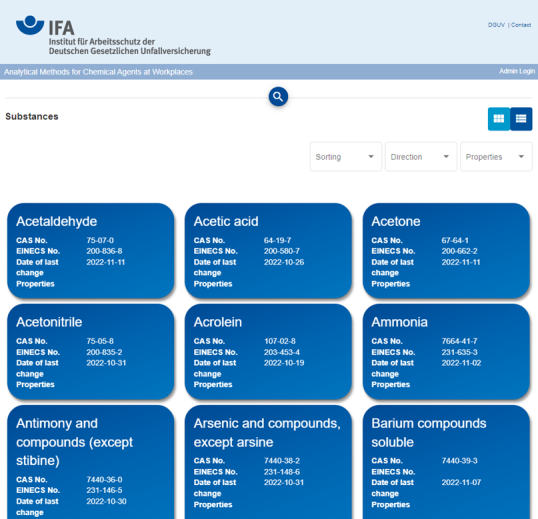- GESTIS Substance Database
- GESTIS Biological Agents Database
- GESTIS-Stoffenmanager®
- ISi information system for safety data sheets
- GESTIS - Analytical methods
- GESTIS - International limit values for chemical agents
- GESTIS DNEL list
- GESTIS - Scientific criteria documents
- GESTIS-DUST-EX
- Exposure database MEGA
GESTIS - Analytical methods for chemical agents
Content
The AMCAW database of analytical methods for chemical agents at workplaces contains suitable validated methods for measuring hazardous substances in workplace atmospheres. Substances of importance owing to their relevance to occupational safety and health are listed, and the associated methods are evaluated against European standards for their suitability and quality. The criteria for selection of a substance include the number of analyses available for it, the existence of an EU limit and the relevance of the substance to occupational safety and health.
The AMCAW provides a quick and user-friendly overview of methods used by various occupational safety and health institutions to measure hazardous substances at the workplace. Important methodological parameters are presented at a glance. These include the principle of the method, i.e. the sampling conditions and preparation of the samples, the analytical method, limits of detection and quantitation, the working range of the method, and the associated expanded measurement uncertainties. In addition, each measurement method is ranked. Methods ranked "A" satisfy the general requirements of EN 482, and the specific requirements of CEN/TR 17055 and/or those of the EN 13205 series. Where the method fails to satisfy the requirements of EN 482 and also lacks the potential to so, it is assigned a "C" ranking. The "B" ranking and a more detailed description of the classification can be found under: Indicative evaluation of the measurement methods. Further information on the selected method is available via the links to the original sources of the methods
The project was funded primarily by the European Commission and the European Free Trade Association (EFTA). DIN (Deutsches Institut für Normung) supported organization of the project in its capacity as the secretariat of CEN TC 137.
The database was created in cooperation with experts from ten European institutes:
- Allgemeine Unfallversicherungsanstalt (AUVA), Austria
- ENI Corporate, Italy
- Eurofins Danmark A/S, Denmark
- Health and Safety Laboratory (HSL), Great Britain
- Institut für Gefahrstoff-Forschung der Berufsgenossenschaft Rohstoffe und chemische Industrie an der Ruhr-Universität Bochum (IGF), Germany
- Institut National de Recherche et de Sécurité (INRS), France
- Instituto Nacional de Seguridad e Higiene en el Trabajo (INSHT), Spain
- Institute for Applied Environmental Research, Air Pollution Laboratory (ITM), Sweden
- Országos Munkahigiénés és Foglalkozás-egészségügyi Intézet (OMFI), Hungary
The database was comprehensively revised and updated by the IFA in 2023. It is now based on a modern database platform, and as a result has been made significantly more user-friendly. Data on 126 substances have been recorded to date. The number of hazardous substances available for reference is set to grow continuously in the coming years.
Use of the database and liability
The database may be used free of charge for occupational safety and health purposes, i.e. for obtaining information on analytical methods for chemical substances. Commercial distribution of the data and their inclusion in full or in part in other information systems is not permitted. Care has been taken during creation and maintenance of the data in the database. However, no liability can be assumed for these data on whatever legal basis.
The application is browser-independent; it has been tested with Chrome (Version 102.0 and later) and Firefox (Version 101.0 and later).
Use of a desktop browser is recommended for the current version. Display problems may arise on mobile devices.
Further information about the database

